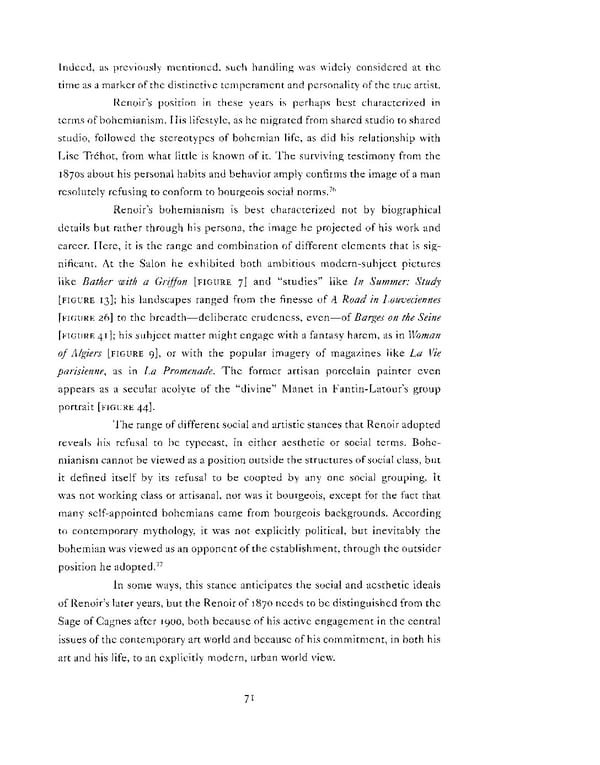Indeed, as previously mentioned, such handling was widely considered at the time as a marker of the distinctive temperament and personality of the true artist. Renoir's position in these years is perhaps best characterized in terms of bohemianism. His lifestyle, as he migrated from shared studio to shared studio, followed the stereotypes of bohemian life, as did his relationship with Lise Trehot, from what little is known of it. The surviving testimony from the 18705 about his personal habits and behavior amply confirms the image of a man resolutely refusing to conform to bourgeois social norms.76 Renoir's bohemianism is best characterized not by biographical details but rather through his persona, the image he projected of his work and career. Here, it is the range and combination of different elements that is sig- nificant. At the Salon he exhibited both ambitious modern-subject pictures like Bather with a Griffon [FIGURE 7] and "studies" like In Summer: Study [FIGURE 13]; his landscapes ranged from the finesse of A Road in Louveciennes [FIGURE 26] to the breadth—deliberate crudeness, even—of Barges on the Seine [FIGURE 41]; his subject matter might engage with a fantasy harem, as in Woman of Algiers [FIGURE 9], or with the popular imagery of magazines like La Vie parisienne, as in La Promenade. The former artisan porcelain painter even appears as a secular acolyte of the "divine" Manet in Fantin-Latour's group portrait [FIGURE 44]. The range of different social and artistic stances that Renoir adopted reveals his refusal to be typecast, in either aesthetic or social terms. Bohe- mianism cannot be viewed as a position outside the structures of social class, but it defined itself by its refusal to be coopted by any one social grouping. It was not working class or artisanal, nor was it bourgeois, except for the fact that many self-appointed bohemians came from bourgeois backgrounds. According to contemporary mythology, it was not explicitly political, but inevitably the bohemian was viewed as an opponent of the establishment, through the outsider position he adopted.77 In some ways, this stance anticipates the social and aesthetic ideals of Renoir's later years, but the Renoir of 1870 needs to be distinguished from the Sage of Gagnes after 1900, both because of his active engagement in the central issues of the contemporary art world and because of his commitment, in both his art and his life, to an explicitly modern, urban world view. ?i
 Pierre-Auguste Renoir: La Promenade Page 78 Page 80
Pierre-Auguste Renoir: La Promenade Page 78 Page 80